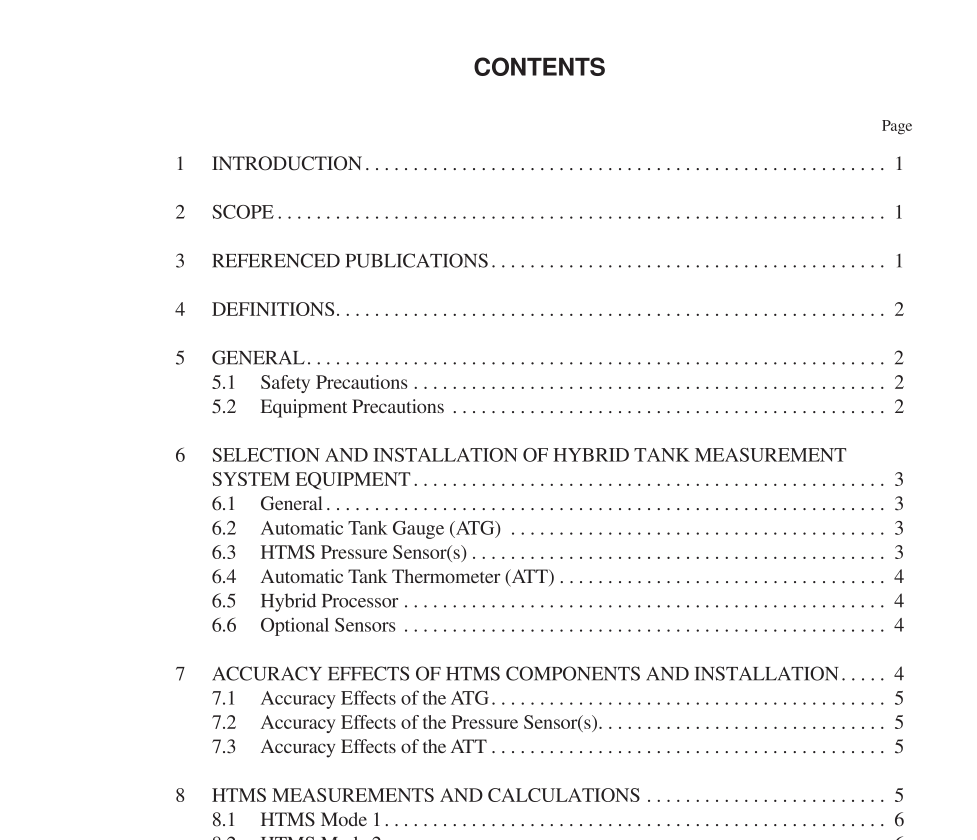API MPMS 3.6 pdf download

API MPMS 3.6 pdf download.Manual of Petroleum Measurement Standards Chapter 3—Tank Gauging
2 Scope
This standard covers selection, installation, commission- ing, calibration and verification of Hybrid Tank Measurement Systems (HTMSs) for the measurement of level, static mass, observed and standard volume, and observed and reference density in tanks storing petroleum and petroleum products. It is up to the user to define which measurements are required for custody transfer or inventory control purposes (standard volume, mass, or both). Therefore, this standard also provides a method of uncertainty analysis, with examples, to enable users to select the correct components and configure an HTMS to more closely address the intended application. (See Appendix B.) This standard covers HTMSs for stationary storage tanks storing liquid hydrocarbons with a Reid Vapor Pressure below 15 psi (103.42 kPa). This standard applies to vertical cylindrical tanks, and can also be applied to tanks with other geometries (e.g., spherical and horizontal cylindrical) which have been calibrated by a recognized oil industry method. Examples of uncertainty analysis for spherical and horizontal cylindrical tanks are also given in Appendix B. This standard does not apply to pressurized tanks or marine applications. This standard covers the installation and calibration of HTMSs for custody transfer and inventory control.
4 Definitions
For the purpose of this standard, the following definitions apply: 4.1 HTMS: A Hybrid Tank Measurement System (HTMS) is a system which uses the product level measured by an auto- matic tank gauge (ATG), the product temperature measured by an automatic tank thermometer (ATT), and the static head of the liquid measured by one or more pressure sensors. These measurements are used, together with the tank capacity table and the product volume/density correction tables, to provide (i.e., display and/or print out) level, temperature, mass, observed and standard volume, and observed and refer- ence density. 4.2 hybrid processor: The computing device compo- nent of the HTMS which uses the level, temperature, and pressure sensor measurements of the HTMS, in addition to stored tank parameters, to compute density, volume, and mass. 4.3 hybrid reference point: A stable and clearly marked point on the outside of the tank wall, from which the position of the pressure sensor(s) is (are) measured. The hybrid refer- ence point is also measured relative to the datum plate. 4.4 zero error of a pressure transmitter: The indica- tion of the gauge pressure transmitter when no pressure dif- ference between input pressure and ambient pressure is applied to the pressure transmitter. This value is expressed in units of pressure measurement (Pascal, in-H 2 O, psi, etc.) 4.5 linearity error of a pressure transmitter: The deviation of the indicated value of the pressure transmitter from the applied pressure as input to the transmitter. This value should not include the zero error and should be expressed as a fraction or percent value of the applied pres- sure reading. 4.6 stable/stability: A measurement is considered stable if the measured deviation has not exceeded its acceptable tol- erance, as defined in this standard, during the last year.
6 Selection and Installation of Hybrid Tank Measurement System Equipment
6.1 GENERAL A Hybrid Tank Measurement System (HTMS) consists of four major components: an automatic tank gauge (ATG), an automatic tank thermometer (ATT), one or more pressure sensors, and a hybrid processor which stores the tank parame- ters and performs calculations. The requirements of these individual components are described below. The user should define whether the HTMS is to be used primarily for standard volume or mass measurements (or both), whether the measurements are to be used for custody transfer or inventory control application, and the correspond- ing degree of measurement accuracy desired. The user or manufacturer should select the HTMS compo- nents and configure the system appropriately to meet the application requirements. The accuracy requirements of the user’s application determines the individual accuracy require- ments of the HTMS components. Section 7 and Appendix B provide guidance and methods to estimate the effects on over- all HTMS accuracy of the individual component selection. To achieve standard volume custody transfer accuracy, the ATG and ATT components should be selected to meet the applicable custody transfer requirements defined in MPMS Chapters 3.1B and 7. To achieve mass custody transfer accu- racy, the pressure sensors should meet the applicable custody transfer requirements defined in MPMS Chapter 16.2. If the HTMS is to be customized for a specific application where high accuracy is required for some parameters but not all, refer to Section 7 for additional guidance. Accuracy pre- diction equations with examples are given in Appendix B to assist users in selection of individual component accuracy requirements.









